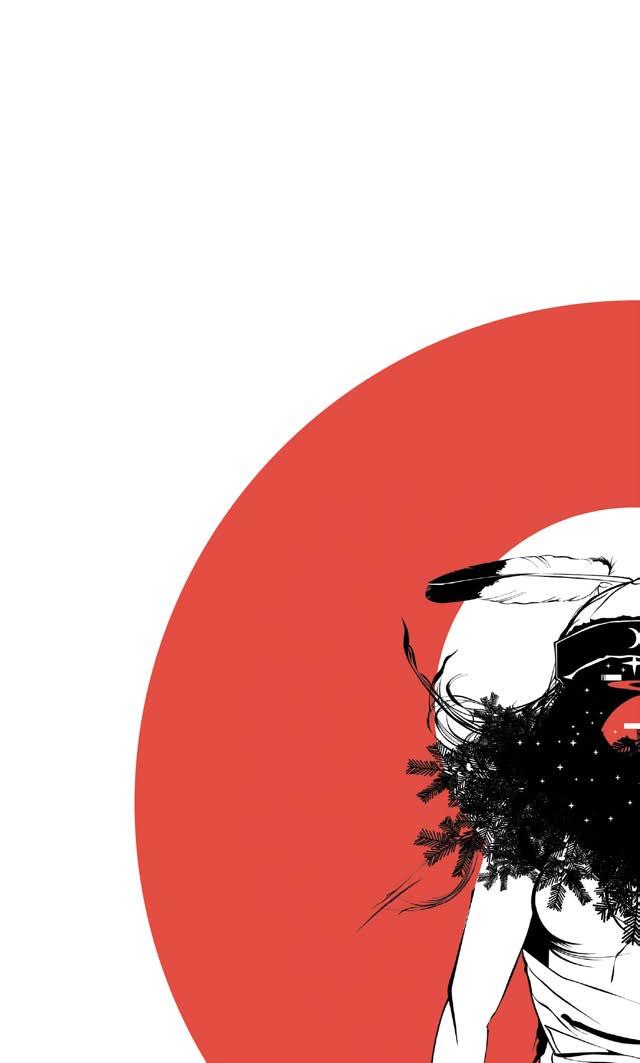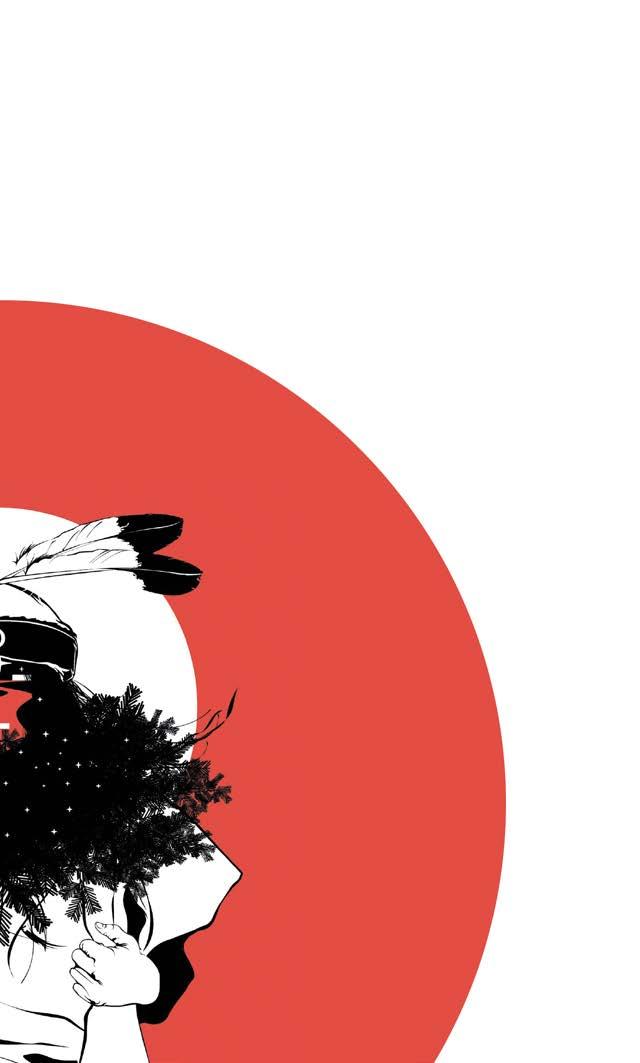
8 minute read
INTRICATE INTERSECTIONS: NATIVE, TWO-SPIRIT, ANDQUEER IDENTITIES
“I think I always knew I was gay at probably the age of 3 or 4, and at some point, I started really looking up to my brothers. I had three older brothers at the time, and they used to dance in the Powwows. They used to be Fancy War Dancers, and I used to mimic them all the time,” Jolene (Bean) Yazzie explains. Yazzie, whose pronoun is ‘bah’ from bah’s Native, Navajo language, is gay, Two Spirit and Navajo and works as a graphic designer. Bah has experienced a lifetime of pushback because of these identities; not only outside of the Native, Indigenous communities and cultures, but even from directly within them.
“Being one of the boys, and not being able to be a boy, especially in a girl’s body, is really hard,” bah admits. Wanting to dance in the dance styles bah’s brothers were permitted to, Yazzie explains that while bah had the support of both parents, the traditions and the elders stood in the way of that. “My dad had to find somebody to initiate me, which is basically welcoming me into the Powwow circle. A lot of older men said no, and my dad was getting really frustrated because he didn't think that it was a problem, but he just kept asking people, and one man said that it was OK,” Yazzie says.
While bah’s wish of being initiated into the Powwow circle eventually came true, Yazzie was bullied for a long time after. “I wouldn't say it broke me; it made me stronger, but it made me also question my own elders and their beliefs,” Yazzie says. In trying to find ways of dealing with that struggle, Yazzie found art as a way of expressing that frustration. Two of bah’s brothers were incredibly artistic and challenged Yazzie in developing those creative and channelling skills. Through trying to mimic what bah saw in magazines and comics, it quickly became apparent that there was a major gap in representation within those pages. “I started to notice how some superheroes, I couldn't really relate to any of them—because, you know, there's the favorites of Spiderman, Batman, Wonder Woman, and Superman—I could just never relate to any of them,” Yazzie explains. In thinking about what kind of superhero Yazzie may be able to relate to, bah was also bearing witness to dear friends enduring traumatic life experiences such as rape, molestation, and domestic violence. It was through these stories and wanting to provide these individuals safety and strength that bah began to draw strong women warriors and created the series Sisters of War. “In our creation stories, they don't really talk about women warriors, and that's one thing I always wanted to capture, especially with their regalia. Some of them that you've seen; they have hats on, and usually men warriors are supposed to only wear the hats. So, even when it comes to sexism, the stereotypical roles of a woman's place and a man's place, I started to question those and tried to turn a woman's role into a man's role,” Yazzie elaborates. Oftentimes, bah’s artwork is considered controversial within Native communities because of its challenge of binary representation and regalia. However Yazzie's work has also been embraced by many in the community and has been featured in many murals and art exhibitions, including the Harwood Museum of Art, the National Museum of the American Indian in In addition to creating the comic, superhero-style series Sisters of War, Yazzie has collaborated with spouse Hannahbah Blue on extremely impactful and necessary projects which highlight the stories, struggles, and tragedies of women within Indigenous communities.
The Sing Our Rivers Red event and movement showcased a display of intricate, delicately designed, and beautifully crafted earrings, and while each piece embodied a traditional, Native beauty, each earring is missing its other half. As a way of awareness to the innumerous number of Native and Indigenous women who are murdered and/or go missing, organizers, including Blue, brought the annual display to America from Canada.
Canada has tracked the number of missing and murdered Indigenous women since 1980, yet as of 2020, law enforcement in the United States still does not have adequate agencies established to track and respond to these horrendous events.
Blue is a poet and wrote pieces reflecting on these tragedies to bring awareness, and ultimately change, while Yazzie created an illustrated art piece to bring a visual representation to the words Blue composed. The collaboration between them was titled Make the Night Holy Again, as many times, it is at night when Native and Indigenous women go missing. While Blue and Yazzie are life and collaborative partners, they also share a unique experience in facing oppression from every angle as they navigate through life. From the AngloAmerican perspective, they are misunderstood in their Native and Two-Spirit identities, and within their Navajo community, they are misunderstood as Diné, LGBTQ-identified women. “I think the biggest thing that we've experienced is people not knowing and not having a lot of connection, understanding, or awareness of our communities, and that's been frustrating,” says Blue. “Even though it's not blatant racism, it’s still harmful. We've definitely felt embraced here (in Denver) as a gay couple, but the intersectionality of being gay and Native, it's just like people don't really know how to interact with us.”
The couple are preparing to leave Denver so they can move back to New Mexico in order to be closer to family. Due to COVID-19, their Navajo tribe members and family have experienced intense and tragic impacts, so moving back feels like the right thing to do. However, the decision doesn’t come without some trepidation. “Our reservation, even though we have in our creation story and this tradition of accepting and really valuing TwoSpirit people, we still had a hard time finding a medicine person who would conduct our wedding,” Blue says. She goes on, “I think our traditional knowledge has been greatly influenced by colonization, assimilation, and Christianization, and that’s even affected our ceremonies. The ‘traditional Navajo ceremony’ is very gendered and focused on
procreation.”

The now-married partners had to source outside of the traditional, ceremonial leaders and scripts in order to have their wedding. One medicine woman whom the couple asked to perform their ceremony said she wouldn’t feel comfortable because, while there once was a ceremony for LGBTQ weddings, it stopped being performed due to the Christian influence in their tribe and has since been lost.
“Even our own tribe doesn’t have gay marriages; even our own tribal government is not allowing us to have the marriage license in the Navajo Nation,” Yazzie laments. With the many genders that are expressed within the Navajo language and accepted within that community, including the encompassing Two-Spirit term, many of the traditions are still based on the gender binary and create issues similar to the LGBTQ hierarchy of representation. Blue explains, “Another aspect to it is that there's still this paternalism in our community, even in, like, Western, gay culture, gay men have arguably more visibility, at times more power.” There is a greater understanding that if there is not equal access to participation in ceremony and representation of all genders within the traditions, women, gender-variant, and LGBTQ folks are deemed less valuable. “There's this huge movement going on in our communities across all native tribes around decolonization trying to detangle the practices or traditions that have been affected due to colonization,” Blue explains. “But, I think what's been left out of that is our Two-Spirit culture. “It seems to me that decolonizing is trying to get back to a certain place, but what is that place we're trying to get back to? How can we rather move forward, support young people, incorporate culture, and come up with new ceremonies?”

Facing obstacles in every direction, the couple find relief in the fact that they can go through these experiences with the support of one another. Whether it be pushback about their marriage within their own tribe or misunderstanding of their genderqueer identities from those who aren’t of the Indigenous heritage, through art, poetry, and love, the pair, and the Two-Spirit community at large, can find recognition and acceptance from one another. Yazzie concludes, “It's like we’re stuck in the past, and that's the problem. I know it's really important, but this is now, you know, and especially when we're thinking about having a family. What kind of world do I want my kids to be living in when I'm gone? I want them to be able to go to a medicine man or woman and be like, ‘I identify as nonbinary, and this is who I'm with, and can you marry us?’ “I hope they don’t have a problem like we did.”
Through the art and vulnerability of folks like Yazzie and Blue, conversations can spark, and the awareness and understanding of the intricate intersections of identity and tradition can truly be explored. For Two-Spirit and LGBTQ Native and Indigenous folks, there has not been a place for them to safely share their truth for far too long. While Yazzie’s and Blue’s story is not encompassing as the story, it is through these conversations that we can shed light on the issues of oppressed, marginalized, and misrepresented communities.
WE BELIEVE THE EMPHASIS IN LIVING WITH HIV SHOULD BE ON LIVING.
Introducing Vivent Health, founded on the combined expertise of AIDS Resource Center of Wisconsin, Rocky Mountain Cares and St. Louis Effort for AIDS. We are working to ensure that everyone living with HIV and everyone at risk has the opportunity to thrive and live a long healthy life. Learn more at ViventHealth.org








